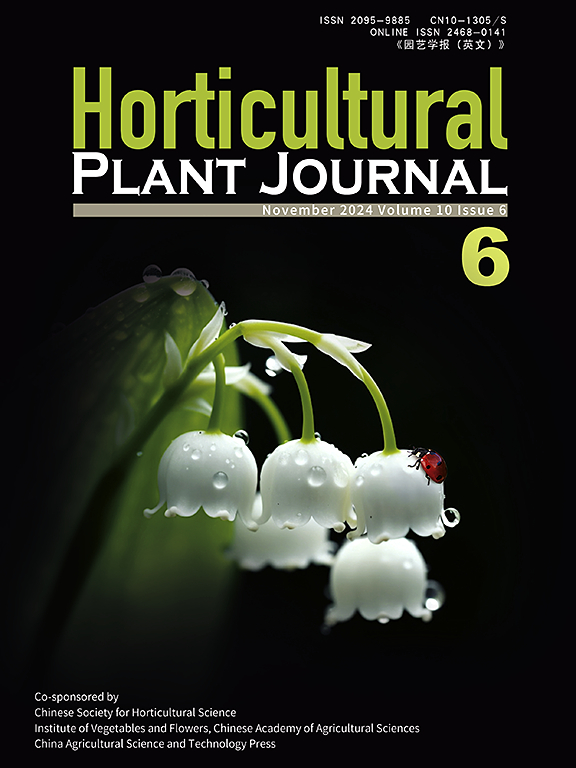VvMYBA1 and VvMYB3 form an activator–repressor system to regulate anthocyanin biosynthesis in grape
IF 5.7
1区 农林科学
Q1 HORTICULTURE
引用次数: 0
Abstract
Anthocyanins are important metabolites that provide a red or blue–purple hue to plants. The biosynthesis of these metabolites is mainly activated by the MYB-bHLH-WD40 (MBW) complex and repressed by a wide variety of proteins. Studies have shown that MYB activators activate MYB repressors to balance anthocyanin biosynthesis. However, there is a scarcity of studies investigating this mechanism in grapes. To explore the transcription factors involved in the regulation of anthocyanin biosynthesis, we reanalyzed the RNA-seq database for different developmental stages of ‘Muscat Hamburg’ berries, and the R2R3-MYB gene, annotated asVvMYBA1 和 VvMYB3 形成一个激活-抑制系统,调节葡萄中花青素的生物合成
花青素是一种重要的代谢物,可为植物提供红色或蓝紫色调。这些代谢物的生物合成主要由 MYB-bHLH-WD40 (MBW) 复合物激活,并由多种蛋白质抑制。研究表明,MYB 激活因子会激活 MYB 抑制因子,从而平衡花青素的生物合成。然而,对葡萄中这一机制的研究还很少。为了探索参与花青素生物合成调控的转录因子,我们重新分析了'汉堡麝香葡萄'浆果不同发育阶段的 RNA-seq 数据库,并筛选了 R2R3-MYB 基因(注释为 VvMYB3)。我们的研究发现,葡萄栽培品种'Y73'的花青素含量高于其亲本栽培品种MH,并且通过qRT-PCR发现推定抑制因子VvMYB3在'Y73'中高表达。胼胝体转基因试验表明,VvMYB3的抑制活性是由bHLH结合基序以及C1和C2基序赋予的。酵母杂交和芯片-PCR分析表明,VvMYB3可通过与VvMYBA1竞争与VvMYC1结合,并通过C2基序促进VvUFGT的组蛋白去乙酰化,从而抑制花青素的生物合成。然而,VvMYB3 的表达是由 VvMYBA1 激活的,这就形成了一个负反馈调节环来调节花青素的积累。此外,我们通过测序在'Y73'的 VvMYBA1 启动子区域发现了一个 408-bp 的重复串联序列插入。GUS 活性分析表明,该序列增强了 VvMYBA1 的表达,导致花青素过度积累。总之,我们的研究结果为了解葡萄花青素激活-抑制系统提供了帮助,该系统可防止花青素的过度积累。
本文章由计算机程序翻译,如有差异,请以英文原文为准。
求助全文
约1分钟内获得全文
求助全文
来源期刊

Horticultural Plant Journal
Environmental Science-Ecology
CiteScore
9.60
自引率
14.00%
发文量
293
审稿时长
33 weeks
期刊介绍:
Horticultural Plant Journal (HPJ) is an OPEN ACCESS international journal. HPJ publishes research related to all horticultural plants, including fruits, vegetables, ornamental plants, tea plants, and medicinal plants, etc. The journal covers all aspects of horticultural crop sciences, including germplasm resources, genetics and breeding, tillage and cultivation, physiology and biochemistry, ecology, genomics, biotechnology, plant protection, postharvest processing, etc. Article types include Original research papers, Reviews, and Short communications.
 求助内容:
求助内容: 应助结果提醒方式:
应助结果提醒方式:


